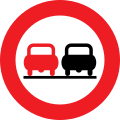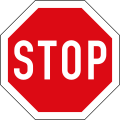Traffic signs
A traffic sign ( VZ for short ) in Germany is a symbol, lettering or line that is placed on the road in the form of a sign ( traffic sign ) or is marked on the roadway and is used to influence or regulate road traffic . In Switzerland, road signaling is the generic term, a single signal is called a signal . Signals do not include markings.
Traffic signs are part of the road equipment and are ordered by the authorities. In addition to permanent traffic signs, there are also variable message signs .
The following rule is binding for observing traffic signs: Signs from police officers or traffic cadets (Article 67 SIA ) have priority over all signs and other rules. Traffic signs have priority over traffic signs. Traffic signs have priority over general traffic rules . (Memorandum: "Policeman in front of traffic lights, traffic lights in front of a sign." )
The traffic signs have largely easy-to-understand and self-explanatory pictograms , which indicate to road users that there is a traffic law order. To traffic signs include the landmark signs which serves the targeting and orientation of the road users.
National
Germany
The sans serif font from the Linear-Antiqua family according to DIN 1451-2 is used on the traffic signs . Details on the setting up of traffic signs can be found in the administrative regulation for road traffic regulations ( VwV-StVO ). There it is ordered that a maximum of three traffic signs (usually a maximum of two regulatory signs) may be attached to a post, §§ 39–43 Paragraph 3 No. 11 VwV-StVO. There are exceptions for signs for stationary traffic. Hazard signs are always on their own. Furthermore, signs with mandatory waiting must be set up alone. Signs indicating right of way (such as giving way or giving right of way ) must be recognizable by the shape of the sign as well as their sign. In this way, the road user can recognize the right of way at a junction even if the sign is damaged or snowed in. If other road signs such as speed limits (e.g. due to snow) are unrecognizable, the general traffic rules apply (in urban areas 50 km / h, on country roads 100 km / h, on motorways 130 km / h). However, drivers who are familiar with the area are required to keep to the usual speed (for example in the 30 zone) even if the signs are not visible.
Depending on the speed driven, you can choose from three different size classes. Large signs are to be placed where traffic flows at high speed and there is little time to grasp a sign. The signs of all sizes are to be designed to be retroreflective for reasons of night visibility or, alternatively, to be illuminated from the inside. The diameter of round blanks is 42 cm, 60 cm or 75 cm, sides of triangles 63 cm, 90 cm or 126 cm and of squares 42 cm, 60 cm or 84 cm.
A traffic sign with production and assembly costs between 120 euros and 150 euros per piece (as of 2008). Private individuals are generally not allowed to put up traffic signs; an exception is the securing and marking of construction sites, but this also requires the prior consent of the responsible road traffic authority.
In Germany in 2008 there were 20 million traffic signs (- including motorways - one every 28 m), plus 3.5 million signposts.
Austria
In Austria, the appearance of the traffic signs is regulated and named according to the road traffic regulations (StVO, Section D, §§ 48–54). The implementing regulations are given in the Road Traffic Sign Ordinance (StVZVO 1998).
For a long time it was unclear to what extent the signage had to correspond to the signs given in the StVO 1960. The sign manufacturers often deviate somewhat from the exact representation in the Federal Law Gazette. In 2015, the Supreme Administrative Court ruled that the signs “do not have to correspond exactly to the StVO”, the decisive factor is that “there is no doubt” that a relevant traffic sign would be recognized in order to have been properly announced.
Switzerland and Liechtenstein
International standardization
For many years there has been an international effort to standardize traffic signs. This facilitates cross-border traffic and improves road safety. Furthermore, a large number of traffic signs contain pictograms in order to accelerate the understanding and comprehension by the linguistically unfamiliar road user.
In the Vienna Convention on Road Signs (November 8, 1968) and the Supplementary Agreement to the Convention on Road Signs (May 1, 1971), most European and South American countries as well as Iran, Thailand, the Philippines, South Korea and Ghana partially agreed to standardize traffic signs. For example, the round stop sign in German-speaking countries was replaced by the octagonal stop sign used internationally (Germany, Austria, Switzerland 1968, in the GDR only 1977).
More signage
In addition to the official traffic signs, which are aimed at normal road users, there are other signs on the streets. These are for example:
- Technical information on traffic structures that go beyond a driving ban (vehicle classes, tonnage limits):
- In (West) Germany, round, ocher-colored signs indicating the military load class (MLK) are used for military vehicles to identify the load-bearing capacity of bridges .
- Many roads are marked with milestones , kilometer signs or station signs . These are used to measure the number of kilometers on the road in order to enable orientation or position determination, for example in the event of accident reports.
- Commonly used the names of tunnels; In Austria there are also river names in front of bridges on motorways, expressways, state roads (blue or green)
- Additional information for the road maintenance department:
- in Austria the municipal boundaries on overland roads (low white boards with a "T" -like sign and the municipality names)
- In Switzerland there are special signs for snow plows that indicate in which area snow can be deposited on the roadside. These signal above all the areas of overpass structures. This is to prevent snow from falling onto the roadway below. A red sign indicates the beginning of the prohibited zone, the green sign cancels the ban. The signs are available in two versions: one shows a stylized clearing vehicle with a snow plow, the other only shows the snow plow and is therefore more difficult to interpret.
- In localities the street names are shown with street signs . In some countries these are not part of the official traffic signs.
- In addition to the official signpost traffic signs, there are other signposts in many countries , for example for hiking trails and tourist destinations.
- In Austria: information boards about sights in front of motorway exits (brown); officially according to StVO, however: Signposts to local or area destinations, such as tourist destinations, public facilities, restaurants and company entrances (green arrow signs or green background on signposts)
- Signs for local public transport are also set up in public traffic areas, often also on the roadside, but are not actually part of the traffic signs, as they are not aimed directly at those involved in road traffic.
Signage of the military load class in the old federal states of Germany
Station board on a Bavarian state road
Graz street sign in the Lend district
Signpost for hiking trails in Switzerland
Smiley as signage of a permanent construction site in Germany
Information sign for tourists in Hamburg's Überseequartier
Web links
Individual evidence
- ↑ a b § 39 traffic signs . In: Road Traffic Regulations . Federal Ministry of Justice. Retrieved April 2, 2013.
- ↑ PIARC Dictionary - term "Verkehrszeichen" ( Memento of the original from February 13, 2015 in the Internet Archive ) Info: The archive link was inserted automatically and has not yet been checked. Please check the original and archive link according to the instructions and then remove this notice.
- ^ Civil engineering department of the Canton of Zurich: Signs , accessed on February 13, 2015
- ↑ § 37 alternating light signals, permanent light signals and green arrow . In: Road Traffic Regulations . Federal Ministry of Justice. Retrieved April 2, 2013.
- ↑ § 36 Signs and instructions of the police officers . In: Road Traffic Regulations . Federal Ministry of Justice. Retrieved April 2, 2013.
- ↑ VwV-StVO point 19 in the section "On §§ 39 to 43 General information on traffic signs and traffic facilities"
- ↑ Can you actually ... ignore snow-covered traffic signs? . n-tv.de. January 8, 2019. Retrieved January 10, 2019.
- ↑ a b Michael Ebert, Timm Klotzek (ed.): Neon useless knowledge . 1,374 bizarre facts that you will never forget. Heyne, 2008, ISBN 978-3-453-60102-4 .
- ↑ road traffic; Construction site security . In: Bavarian Authority Guide . StMI Bavaria. Retrieved August 19, 2012.
-
↑ a b knowledge management Court (VwGH) Gfz. o 2015/02/0022 of November 20, 2015 (online, ris.bka );
Incorrect traffic signs are valid according to the highest court . In: Salzburger Nachrichten . January 5, 2016, local section Stadt und Land , p. 4 (quotations ibid). The figure shows the approximate appearance of the treated board according to the article in Salzburger Nachrichten (here the corresponding Czech symbol is shown).
- ^ Vienna Convention on Road Signs
- ↑ United Nations Tready Collection: 20. Convention on Road Signs and Signals, Vienna, November 8, 1968 ( Memento of the original from February 13, 2015 in the Internet Archive ) Info: The archive link has been inserted automatically and has not yet been checked. Please check the original and archive link according to the instructions and then remove this notice.












